Introduction
Overall Design
{{section_header}}{{section.name}}{{/section_header}}
Panasonic doesn't seem to put as much stock in a sleek design as Samsung or Sony, for better or for worse. We have to admit that most Samsungs and Sonys have a lot more eye appear than this TV. But when the screen is on, the frame tends to disappear, so maybe it's not all that important.
Front
{{section_header}}{{section.name}}{{/section_header}}
The front of the Panasonic TC-P42S2 is mostly screen (as you might guess). There are some indicator lights at the bottom.

Back
{{section_header}}{{section.name}}{{/section_header}}
The back of the Panasonic TC-P42S2 houses most of the ports.

Sides
{{section_header}}{{section.name}}{{/section_header}}
The sides show how thick a plasma TV can be compared to much skinnier LCD models. On the right side you'll find a handful of ports and the onboard controls for basic functionality like power, volume, and source input.

Stand/Mount
{{section_header}}{{section.name}}{{/section_header}}
The stand is plenty sturdy, but does not allow the TV panel to swivel. That's no good in our book.

Controls
{{section_header}}{{section.name}}{{/section_header}}
The onboard controls on Panasonics are usually big, fat plastic buttons like these. They may not be pretty, but they're easy to find and feel solid and responsive.

Remote Control
{{section_header}}{{section.name}}{{/section_header}}
The remote control is hardly sleek, but it does the job.

In the Box
{{section_header}}{{section.name}}{{/section_header}}
The Panasonic TC-P42S2 is not too heavy for a 42-inch display, so one person, with a good build and proper footing, should be able to set the TV up on their own. Inside the box, you'll find the stand, remote control, batteries, and an instruction manual and other documentation.
Black Level
{{section_header}}{{section.name}}{{/section_header}}
The Panasonic TC-P42S2 showed a good performance in the black level test, though it failed to beat the other Panasonic plasma display, and even a Samsung LCD. In the chart below, you can see how it stacked up. Remember, the lower the black level, the better. More on how we test black level.
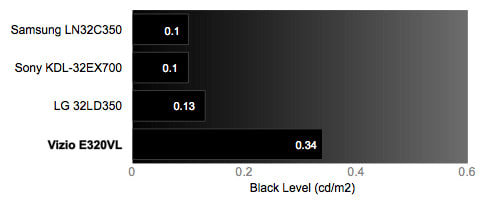
Peak Brightness
{{section_header}}{{section.name}}{{/section_header}}
The Panasonic TC-P42S2, like most plasma TVs, fails to deliver bright whites. Look at the chart below. The top two TVs are LCD units and the bottom two are plasmas. Now, most people don't consider a bright white as important as a deep black, but for practical purposes, you want a TV that delivers at least a little of each. TVs without a bright picture can be difficult to watch in a sunny room. The Panasonic TC-P42S2 was not the worst we've seen, but it's something to consider before buying any plasma. More on how we test peak brightness.
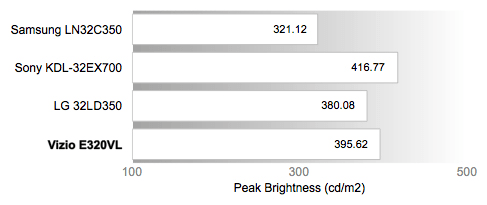
Contrast
{{section_header}}{{section.name}}{{/section_header}}
The Panasonic TC-P42S2 produced a decent contrast ratio of 1860:1, by our measurements. Sure, that doesn't come close to whatever ridiculous number the manufacturers probably provided, but it never does. Our contrast ratio test measures how black and how bright can a TV get under the same conditions, that is to say, without lowering brightness and backlight and cherry-picking the best results from each setting.
As you can see below, the Panasonic TC-P42S2 falls behind the other Panasonic plasma, and well behind the Samsung LN40C630, but better than the Sharp LC-40LE700. More on how we test contrast.

Tunnel Contrast
{{section_header}}{{section.name}}{{/section_header}}
The Panasonic TC-P42S2, like many plasmas, has a hard time maintaining a consistent black level. Picture a rectangle of black in the center of the screen, surrounded by a just a little white. That's the right end of the scale. Now picture that black rectangle shrinking, and the white trim around it growing. As more bright white appears, that black doesn't stay quite as dark. You don't see this problem with LCD displays, but the chart below shows what happens to the typical plasma. More on how we test tunnel contrast.
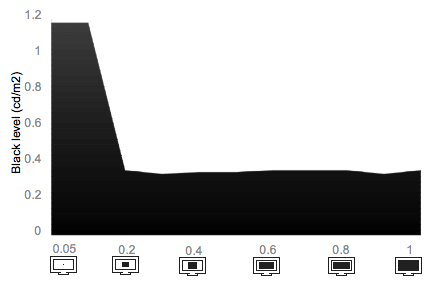
White Falloff
{{section_header}}{{section.name}}{{/section_header}}
The Panasonic TC-P42S2 also showed some problems with maintaining a consistent peak brightness, which is tested like Tunnel Contrast (above), but in reverse. Again, it's a problem for many plasma TVs, but less so for LCDs. More on how we test white falloff.
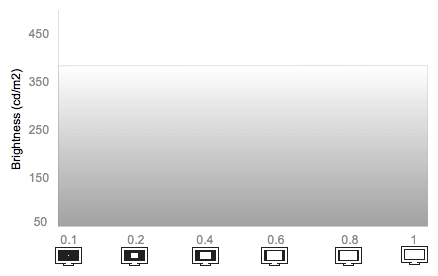
Uniformity
Greyscale Gamma
{{section_header}}{{section.name}}{{/section_header}}
The greyscale gamma test measures how well a TV transitions from black to white. Look at the chart below. First, we're looking for a smooth line. Bumps in the line indicate problems where we might see some lack of detail. As you can see, though, the Panasonic has no problems. As you get towards the upper right, which indicates the highlights, it starts to taper into a horizontal like. That indicates that the TV may have some loss of detail in the brightest parts of the signal, but it doesn't look too severe. Finally, we look at the overall slope of the curve. An ideal gamma is somewhere between 2.1 and 2.2. A slope of 2.09 is a bit on the shallow side, but very good overall. More on how we test greyscale gamma.
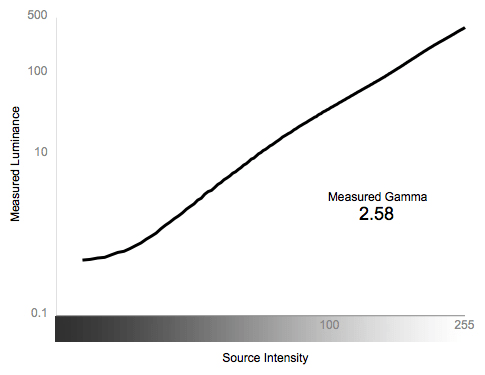
Color Temperature
{{section_header}}{{section.name}}{{/section_header}}
The Panasonic TC-P42S2 showed no problems maintaining a consistent color temperature. More on how we test color temperature.

RGB Curves
{{section_header}}{{section.name}}{{/section_header}}
The Panasonic TC-P42S2 had mixed results on the RGB color curve test. The chart below traces the performance of the red, green, and blue color channels, tested at each of their 255 values from darkest to brightest. An ideal chart would show smooth lines moving in unison (more or less). The Panasonic TC-P42S2's chart has a lot of squiggles, each of which indicates some problem with displaying that portion of the spectrum. Portions where the line becomes horizontal, like the upper-right blue line, indicates an area where the TV simply can't display any differentiation between those values. Overall, we've seen a lot worse than this, but we were not terribly impressed. More on how we test RGB curves.

The color strips below are digital recreations of the actual color response of each channel, compared with three similar televisions. If you compare it to the chart above, you can usually see correlations between bumps in the curve and visible shifts in color strips.
Motion Performance
{{section_header}}{{section.name}}{{/section_header}}
Motion Smoothness (7.5)
The Panasonic TC-P42S2, along with most plasmas, seems to produce smoother motion that LCD TVs. It was clear that objects in motion lost some fine detail, but it was minimal compared to the last several LCD reviews we've done. The TV offers a Blur Reduction feature in the menu, but it seemed to have much less of am impact than similar features on LCD units. Typically, this feature produces a disarmingly smooth image that looks bizarre, especially when watching film-based content. The Panasonic TC-P42S2's Blur Reduction was more conservative, recovering some of that fine detail loss without making a movie look too weird.
Motion Artifacting (5.25)
The Panasonic TC-P42S2 is already at a little fuzzy, even at its best. It's the nature of plasma displays, and it's readily apparent if you sit too close. Given that baseline, we noticed a fair amount of detail and color smearing as the test patterns and other images moved across the screen. Like a vaseline lens, everything's a little fuzzy. It's not this way with all plasmas. The Panasonic TC-P42U2 seemed a little sharper than this. When we activated the Blur Reduction feature, it had very little effect on the sharpness or artifacting. More on how we test motion performance.
3:2 Pulldown & 24fps
{{section_header}}{{section.name}}{{/section_header}}
The Panasonic TC-P42S2 had no problems with displaying film-based content in a 24fps format (i.e. most Blu-ray movies). In order to get the best performance, be sure to put the '3:2 Pulldown' feature (located in the Advanced Picture menu) in auto mode. More on how we test 3:2 pulldown and 24fps.
Resolution Scaling
{{section_header}}{{section.name}}{{/section_header}}
The Panasonic TC-P42S2 has a native resolution of 1080p (1920 x 1080). But most of the video you'll be watching from cable, satellite, and other sources will be of a lower resolution. It's up to the TV's internal processing to upscale that content to fit on the screen. More on how we test resolution scaling.
480p
When viewing 480p content, the Panasonic TC-P42S2 lost 2% of the sides and 2% of the top and bottom due to overscan.
720p
With 720 p content, the TV also lost 2% on all sides due to overscan, and showed some problems with high-frequency patterns.
1080i
The 1080i content was the worst, which is unfortunate, because it's the most pervasive HD content resolution. While there was no overscan loss, we saw lots of problems with Moires appearing in high frequency patterns. False coloration, false geometric patterns, flashing, and jittering were all present in various types of patterns. How often you'll encounter these in everyday viewing is hard to say. We tend to notice it a lot in clothes with tight checkered or striped patterns.
Formats
{{section_header}}{{section.name}}{{/section_header}}
The Panasonic TC-P42S2 has a native 1080p (1920 x 1080) format, and supports all types of NTSC content.
Viewing Angle
{{section_header}}{{section.name}}{{/section_header}}
The Panasonic TC-P42S2 has an outstanding viewing angle, measuring a full 160 degrees (80 degrees from center in either direction). That far exceeds the competing LCD televisions, and even beats the other Panasonic plasma we've selected for comparison.

Reflectance
{{section_header}}{{section.name}}{{/section_header}}
The Panasonic TC-P42S2, like most plasmas, has a screen that creates wide, diffuse reflections when a light shines on it. It means you may have to get creative about where you position the TV in relation to lights in the room.
Video Processing
{{section_header}}{{section.name}}{{/section_header}}
The Panasonic TC-P42S2 has a small handful of video processing features, most of which don't do a whole lot to help or harm the picture quality.
Calibration
{{section_header}}{{section.name}}{{/section_header}}
The Panasonic TC-P42S2 was easy to calibrate once we put it in Cinema mode. This mode turns off most of the extraneous processing features and offers the best color accuracy.

All of our calibration is done in conjunction with the DisplayMate software.
](http://www.displaymate.com/)
Video Modes
{{section_header}}{{section.name}}{{/section_header}}
The Panasonic TC-P42S2 has several video modes. Pick your favorite. We like Cinema mode.
Ergonomics & Durability
{{section_header}}{{section.name}}{{/section_header}}
The remote that ships with the Panasonic TC-P42S2 (model number N2QAYB 000485) is not beautiful, but it works just fine. The ridge that runs along the bottom digs into your fingers more than most remotes, but it's so lightweight that it probably won't bother you.
Button Layout & Use
{{section_header}}{{section.name}}{{/section_header}}
The buttons on the remote control are plainly labeled and easy to use. Those that control the menu are located near the top. The most frequently used buttons – the volume and channel up/down – are conveniently located in the center.
Programming & Flexibility
{{section_header}}{{section.name}}{{/section_header}}
The remote control can be used to operate certain other Panasonic AV devices, but it's not programmable as a 'universal' remote.
Connectivity
{{section_header}}{{section.name}}{{/section_header}}
Input Ports (6.0)
The Panasonic TC-P42S2 has a decent number of ports, but it's far from the best we've seen. You'll be able to get started on a home entertainment system, but hardcore techies may be disappointed. Notable inclusions: 3 HDMIs, 2 component AVs, 2 composite AVs, and an SD/SDHC memory card. Notably missing: a VGA input and an analog audio output.

Output Ports (1.0)
The Panasonic TC-P42S2 has just one output port, a digital audio out. There is no analog audio out, which means you may have trouble connecting the TV to older sound systems.
Other Connections (0.0)
The Panasonic TC-P42S2 has no network connections like LAN and ethernet. The TV does not support DLNA.
Media (2.0)
The Panasonic TC-P42S2 has a media card slot that supports SD and SDHC cards. The TV is capable of only playing back JPEGs. Video and audio clips are not supported.
{{product.manufacturer_specs['Connectivity Tour Image 3']}}
Placement
{{section_header}}{{section.name}}{{/section_header}}
The Panasonic TC-P42S2's ports are clearly labeled, and the ports on the side are easy to access. But the TV panel does not swivel on its base, which makes accessing the rear ports more difficult.
Audio Quality
{{section_header}}{{section.name}}{{/section_header}}
The audio performance on the Panasonic TC-P42S2 is not great. Overall, you'll notice a tinny quality because it can't produce a decent bass response. That's no surprise; most TVs are bad at this. The menu allows for control over treble and bass, but there's no full-fledged equalizer. Of course, there's a surround sound emulator, but it only seemed to make the sound tinnier. We recommend leaving it off.
Menu Interface
{{section_header}}{{section.name}}{{/section_header}}
The 2010 Panasonic TVs have a clean, straightforward menu. It should be of benefit to both n00bs and those comfortable with technology. The main menu items are vertically-aligned, so it's clear where you are in the menu. The response time to remote control button pushes is snappy, and if you're ever lost in the menu, you can simply hit the 'exit' button.

Instruction Manual
{{section_header}}{{section.name}}{{/section_header}}
The Panasonic TC-P42S2 has a great instruction manual that ships with the TV, available in English, French, and Spanish. It answers nearly all the questions you might have about the TV's features and options. You can find the Panasonic TC-P42S2's manual online here.

A manual for so many TV models, they have to be further categorized by type.
Internet Features
{{section_header}}{{section.name}}{{/section_header}}
The Panasonic TC-P42S2 does not have a LAN ethernet port or WiFi access to connect to streaming content.
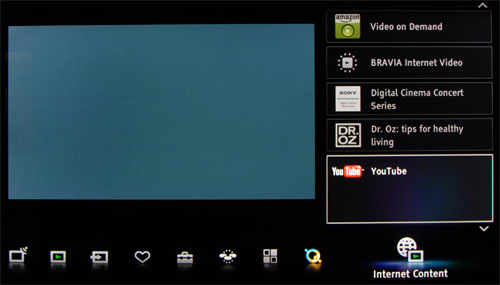
Local Media Playback
{{section_header}}{{section.name}}{{/section_header}}
The Panasonic TC-P42S2 has an SD/SDHC card slot that supports the playback of JPEG still images. When you pop a card in, a little menu pops up asking you if you'd like to view the images. Say yes, and the screen is populated with thumbnails of your pictures. From here, you can view pictures one by one on the big screen, or create a slideshow.
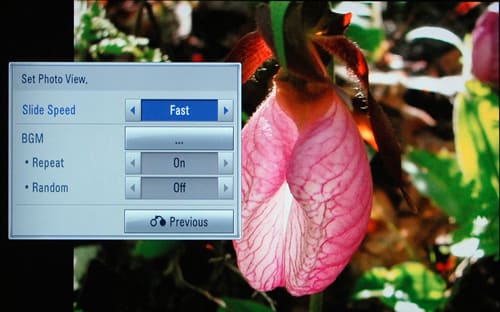
The Panasonic TC-P42S2 does not support the playback of video or audio clips from the card slot.
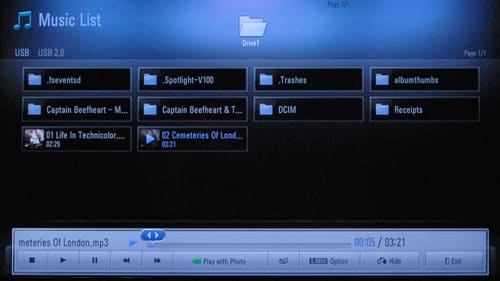
Other Media
{{section_header}}{{section.name}}{{/section_header}}
The Panasonic TC-P42S2 does not support any other type of media.
Power Consumption
{{section_header}}{{section.name}}{{/section_header}}
The Panasonic TC-P42S2 has a big appetite for power, as do most plasma TVs. On average, we expect the TV to cost about $36.33 per year in electricity costs.
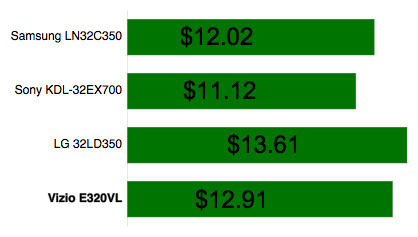
Value Comparison
{{section_header}}{{section.name}}{{/section_header}}
The Panasonic TC-P42U2 is a slightly cheaper plasma TV than the identically sized Panasonic TC-P42S2. The have the same resolution, selection of ports, menus, and features. Whatever design differences and other features that Panasonic used to separate these two is not immediately apparent. On the whole, the U2 has a better black level and contrast ratio, while the S2 has better color performance. We recommend getting the cheaper of the two, depending on what's available at your retailer of choice.
Blacks & Whites
{{section_header}}{{section.name}}{{/section_header}}
The Panasonic TC-P42U2 managed a noticeably darker black level than the TC-P42S2, despite being very similar Panasonic plasma TVs. It made for a significant difference in their respective contrast ratios.

Color Accuracy
{{section_header}}{{section.name}}{{/section_header}}
The Panasonic TC-P42S2 may have fallen behind in contrast ratios, but it managed better color performance than the TC-P42U2 in most respects, and we tend to weight those as being more important.
Motion
{{section_header}}{{section.name}}{{/section_header}}
The Panasonic TC-P42U2 was just a tad sharper in the retention of fine details of objects in motion than the Panasonic TC-P42S2.
Viewing Effects
{{section_header}}{{section.name}}{{/section_header}}
The Panasonic TC-P42S2 managed a slightly wider viewing angle than the Panasonic TC-P42U2.
Connectivity
{{section_header}}{{section.name}}{{/section_header}}
The Panasonic TC-P42S2 and Panasonic TC-P42U2 are identical in their selection of ports.
Value Comparison
{{section_header}}{{section.name}}{{/section_header}}
The Samsung LN40C630 is a superior television by most measures. For roughly the same price, you get a much better contrast ratio, a better interface, more ports, and access to streaming content. The Panasonic TC-P42S2 has better color performance and wide angle, but that's it.
Blacks & Whites
{{section_header}}{{section.name}}{{/section_header}}
The Samsung LN40C630 offers a better black level, despite being an LCD matched up against a plasma TV. Because the white levels were also much brighter, the contrast ratio is far superior.

Color Accuracy
{{section_header}}{{section.name}}{{/section_header}}
The Panasonic TC-P42S2 managed some very good color performance, which the Samsung was not able to best.
Motion
{{section_header}}{{section.name}}{{/section_header}}
The Samsung LN40C630 has video processing features that, when engaged, make for major improvements in motion smoothness and artifacting. The Panasonic TC-P42S2 was a little fuzzy even at its best.
Viewing Effects
{{section_header}}{{section.name}}{{/section_header}}
The Samsung LN40C630 couldn't come close to the Panasonic TC-P42S2 in viewing angle.
Connectivity
{{section_header}}{{section.name}}{{/section_header}}
The Samsung LN40C630 offers much more in terms of connectivity, including more input ports for a basic home theater setup, as well as networking ports like LAN and (optional) WiFi for downloading streaming content from Netflix and others.
Value Comparison
{{section_header}}{{section.name}}{{/section_header}}
The Sharp LC-40LE700 is no top-tier TV. It has a lot of great specs, but failed to deliver on its promises. As a result, you have a TV with average performance, but an above-average price tag. We recommend the Panasonic in this showdown.
Blacks & Whites
{{section_header}}{{section.name}}{{/section_header}}
The Sharp could not nearly match the Panasonic TC-P42S2 for black levels, and the difference between the peak brightness scores is insignificant. As a result, the Panasonic has the better contrast ratio.

Color Accuracy
{{section_header}}{{section.name}}{{/section_header}}
The Sharp LC-40LE700 was no slouch in our color performance tests, but the Panasonic TC-P42S2 edged it out ever so slightly. In real-world terms, we'll call it a draw.
Motion
{{section_header}}{{section.name}}{{/section_header}}
The Panasonic TC-P42S2 and Sharp LC-40LE700 were evenly matched in our motion performance tests, with the Panasonic offering a smoother picture, but the Sharp showing less artifacting.
Viewing Effects
{{section_header}}{{section.name}}{{/section_header}}
The Sharp had the narrowest viewing angle of all the TVs in this round of comparisons.
Connectivity
{{section_header}}{{section.name}}{{/section_header}}
The Sharp LC-40LE700 has plenty of ports, including a LAN for streaming content. Unfortunately, they make poor use of it, offering only text-based content and some games.
Conclusion
The Panasonic TC-P42S2 ($849 MSRP) is an average plasma TV with a few notable problems, but some real bonuses, as well. We were shocked to see the mediocre black levels that even similarly priced LCD TVs can beat. That's one area where plasmas are supposed to excel. There were also problems with the TV maintaining a consistent black level, but that's a widespread problem with plasmas.
In its favor, the Panasonic TC-P42S2 offers excellent color performance and one of the widest viewing angles we've seen in some time. The price is also enticing, particularly if you look at larger models in the S2 series and compare them against similarly sized LED-lit LCD units.
Overall, we can recommend the Panasonic TC-P42S2 only if you have your heart set on buying a plasma but you're working with limited funds. Panasonic makes better plasmas, and there are better LCD TVs in this same size and price range.
Model Series Comparison
{{section_header}}{{section.name}}{{/section_header}}
There are six models in this very large series from Panasonic, with the 42-inch model as the smallest of the bunch. Panasonic does good job of keeping the costs down on this low-frills series. Don't expect much beyond basic performance.
Photo Gallery
{{photo_gallery "Front Tour Image", "Back Tour Image", "Sides Tour Image", "Stand Photo", "Controls Photo", "Remote Control Photo", "Connectivity Tour Image 1", "Connectivity Tour Image 2", "Connectivity Extra Photo", "Menu Main Photo", "Menu 2 Photo", "Internet Features 1 Photo", "Internet Features 2 Photo", "Internet Features 3 Photo", "Local Media Playback 1 Photo", "Local Media Playback 2 Photo"}}
Ratings & Specs
{{manufacturer_specs_table}}
Meet the tester
David Kender oversees content at Reviewed as the Editor in Chief. He served as managing editor and editor in chief of Reviewed's ancestor, CamcorderInfo.com, helping to grow the company from a tiny staff to one of the most influential online review resources. In his time at Reviewed, David has helped to launch over 100 product categories and written too many articles to count.
Checking our work.
Our team is here for one purpose: to help you buy the best stuff and love what you own. Our writers, editors, and lab technicians obsess over the products we cover to make sure you're confident and satisfied. Have a different opinion about something we recommend? Email us and we'll compare notes.
Shoot us an email
